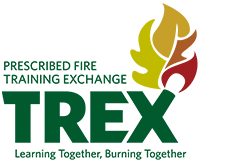

Prescribed Fire Training Exchanges (TREX) address one of the most fundamental ways to shift fire culture: giving more people the opportunity to work with fire. The Fire Networks support beneficial fire, and the people who work with it by investing in prescribed fire partnerships and leadership development and through experiential training events.
To address the wildfire challenges we face, we need many more people to engage with and use beneficial fire. Those people need support, investment, and experiential training. TREX provides a flexible model for delivering locally adapted solutions.
TREX—and the staff and partners who organize and manage them—facilitate training, information sharing and cross-boundary relationship building for people who want to work with fire. TREX serve those looking to advance their formal qualifications at any point in their careers, and connect place-based prescribed burners with training, burning opportunities, and each other.
ABOUT
Prescribed Fire Training Exchanges (TREX) and cooperative burns provide experiential training that builds robust local capacity for fire management and offers fire practitioners a more holistic perspective—while implementing treatments that support community and landscape objectives. TREX provides a unique cooperative burning model that services the needs of a variety of entities, including federal and state agencies, private landowners and contractors, tribes, academics, and international partners—while incorporating local values and issues to build the right kinds of capacity in the right places.

“Fire is local, and the workforce ultimately must be local, and people need to be able to say, ‘Today is a good burn day, call the neighbors, let’s go to work.”
— Jeremy Bailey, prescribed fire training director for The Nature Conservancy

History
The TREX model originated in Fire Learning Network (FLN) landscapes in the Great Plains in 2008 as a way to address critical training bottlenecks that limited the ability to conduct prescribed burns at needed scales. Since then, it has grown, spread, and been adapted to a wide range of geographies, landscape types, and local needs. Dozens of fire practitioners and local leaders have now gained experience in leading TREX. By 2023, dozens of partners had organized more than 140 TREX events in the United States, providing training and hands-on experience to more than 3,800 people and putting more than 170,000 acres of beneficial fire on the ground.
More recently, the pandemic had the effect of reconnecting TREX to the community-based ethos at its foundations. Before the pandemic, most training events relied heavily on non-local practitioners traveling to them, bringing valuable perspectives to the area, but leaving after the event. “During the pandemic, you no longer had practitioners who could come from out of the area to help, which meant you must do everything locally, which really is what all of us believe in at our core,” says Jeremy Bailey, prescribed fire training director for The Nature Conservancy.
